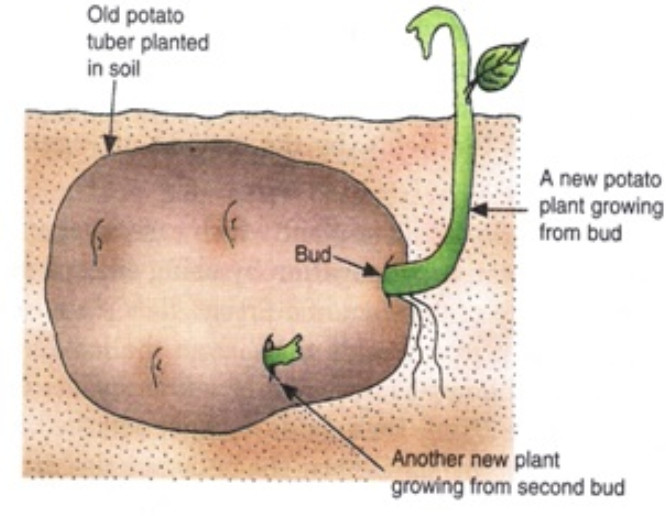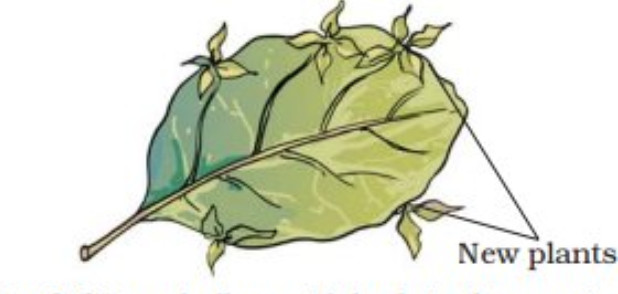Question 1 What is meant by reproduction? Name the two methods of reproduction in plants?
Question 2 What is meant by Vegetative Propagation? Name few plants which are reproduced by Vegetative Propagation?
Question 3 What is meany by asexual reproduction in plants? Name few plants which are reproduced by asexual reproductive method?
Question 4 What is meany by sexual reproduction in plants? Name few plants which are reproduced by sexual reproductive method?
Question 5 Describe the cutting method for the propagation of plants?
Question 6 how do Bryophyllum plants reproduce?
Question 7 How are potato plants reproduce asexually?
Question 8 State two advantages of vegetative reproduction?
Question 9 Define the term node, axil and bud?
Question 10 What are terminal and axillary buds?
Contents
Organisms
All the living things are called organisms.
The production of new organisms from the existing organisms of the same species is called reproduction.
Methods of reproduction in plants
There are different methods (or modes) of reproduction in plants.
Thus, there are two types of methods of reproduction (or modes of reproduction) in plants:
(1) Asexual reproduction, and
(2) Sexual reproduction.
The special cells involved in sexual reproduction are called gametes. Gametes are the reproductive cells which are commonly known as sex cells. Gametes are of two types: male gametes and female gametes.
Asexual Reproduction in Plants
The production of new plants from existing plants without the involvement of gametes (or sex cells) is called asexual reproduction. It is called asexual reproduction because it does not make use of special cells called sex cells (or gametes) for producing new plants. In asexual reproduction in plants, new plants can be obtained from an existing plant without seeds.
Some of the plants which can be produced by asexual reproduction methods (without seeds) are: rose, potato, ginger, turmeric, sweet potato, Dahlia, sugarcane, Bryophyllum and cactus.
Sexual Reproduction in Plants
The production of new plants from existing plants by the fusion of their gametes (or sex cells) is called sexual reproduction. It is called sexual reproduction because sex cells (called gametes) are involved in this method for producing new plants. In sexual reproduction in plants, the fusion of male and female gametes leads to the formation of seeds. In sexual reproduction, new plants are obtained from existing plants through seeds.
Some of the plants which are produced by sexual reproduction method (from seeds) are : wheat, gram (chana), maize (makka), peas, paddy (rice), sunflower, mustard, cotton, and drumstick
Asexual reproduction in Plants
In asexual reproduction, new plants are produced from existing plants without the production of seeds.The new plants obtained by asexual reproduction methods are exactly identical to the parent plants.
The asexual reproduction in plants can take place by the following methods:
(i) Vegetative propagation,
(ii) Budding
(iii) Fragmentation, and
(iv) Spore formation.
Node: Node is a point on the stem (or branch) of a plant where a leaf is attached. Buds are also present in the node regions of a plant.
Axil: Axil is the upper angle between a leaf stalk and the stem (or branch) from which it is growing.
Bud: Bud is a compact, knob-like undeveloped shoot consisting of a shortened stem and immature overlapping leaves .Buds are the growing points of a plant.
1) The buds at the end of a stem or branch are called terminal buds.The terminal buds lead to the elongation (lengthening) of stem and branches. Terminal buds may also develop into flowers.
2) The buds present in the axil of a plant are called axillary buds. Axillary buds are also called vegetative buds. When axillary buds (or vegetative buds) grow, they normally produce branches (with leaves). The axillary buds (or vegetative buds) can give rise to new plants.
Vegetative buds are normally present on the stems and branches of a plant (like that of a rose plant).Vegetative buds are also present on the modified, underground stems of plants (like potato plant). Vegetative buds can also develop on other parts of a plant such as roots and leaves.
For example: vegetative buds are present on the modified, thickened roots of a sweet potato plant, and on the leaves of Bryophyllum plant. The stems, roots and leaves are called vegetative parts of a plant.
Vegetative propagation
In vegetative propagation, new plants are produced from the parts of old plants (like stems, roots or leaves). Vegetative propagation usually involves the growth and development of one (or more) buds on the old part of the plant to produce a new plant. These buds are in the dormant state (inactive state) in the old part of the plant.
Some of the plants which are usually reproduced by the method of vegetative propagation are rose, champa (Magnolia), potato, ginger, turmeric, sweet potato, Dahlia, mint, sugarcane, banana, Bryophyllum, strawberry, Gladiolus, cactus and grapes.
(a) Vegetative Propagation by Stems
The stems (or branches) of plants normally bear buds in the axils which can be used in vegetative propagation to produce new plants. New plants can be obtained from the stem (or branch) of an existing plant by the method of cuttings. A small part of stem (or branch) of a plant which is removed by making a cut with a sharp knife, is called a cutting. While making a cutting, care should be taken to see that there are some buds on it.
The lower end of stem cutting is buried in the moist soil.The upper part of cutting having bud on it is kept above the ground. The cutting planted in soil is watered everyday. After a few days, the cutting develops roots. The bud grows and produces a shoot (branch with leaves)
The plants like rose, champa, grapes, sugarcane, bananas, Bougainvillea can be grown by cuttings method.
Money plant can also be grown by the cuttings method of vegetative propagation. We can grow money plant even in a jar of water by taking a stem cutting (with a node) from an existing money plant.
Advantage of the cuttings method is that by using this method we can produce many new plants from just one plant quickly, without waiting for flowers and seeds.
Some of the plants have modified stems which are short and thick, and grow below the ground (or underground). The underground stems have buds from which new plants can be grown. Such underground stems are called stem tubers.
A tuber is the thickened underground stem (or root) of a plant which is swollen with stored food. The tuber has a number of buds. Each bud of the tuber can grow into a new plant when the old tuber (or its cutting) is planted in the soil in the next growing season.Tubers can be used as organs of vegetative propagation to produce new plants.
There are two types of tubers : stem tubers and root tubers.
Potato is a stem tuber
A potato tuber has many buds (called eyes) on its body which appear like scars. When a potato tuber is planted in the soil, then all the buds of potato tuber start growing to produce new potato plants. Thus, one old potato tuber can produce many new potato plants. We can even plant cut pieces of potato in the soil to obtain new potato plants but each such cut piece should have a bud (or eye) on it.
Each potato plant produces more than one tuber, and each tuber has more than one bud (which produce more than one new plant). The vegetative propagation method of producing potato plants by using potato tuber cuttings is much faster than the production of potato plants from seeds.
Ginger and turmeric are also modified, underground stems swollen with food. The underground stems of ginger and turmeric plants have buds on their body.
(b) Vegetative Propagation by Roots
There are some plants which have modified, thickened roots which bear buds.
For example: sweet potato plant has modified roots thickened with stored food which are called root tubers. The root tubers of sweet potato have buds (eyes) on them which can grow to produce new sweet potato plants. Dahlia also has root tubers. The root tubers of Dahlia have buds in them which can grow to produce new Dahlia plants.
(c) Vegetative Propagation by Leaves
The leaves of some plants develop buds on them. Such leaves having buds can be used as structures of vegetative reproduction in plants.
A plant which can reproduce from its leaves is Bryophyllum (Bryophyllun is also called sprout leaf plant). The leaves of Bryophyllum plant develop some buds in its margins (or edges) When a mature leaf of the Bryophyllum plant falls on the ground, then each bud can grow into a new plant.
Another plant called Begonia also reproduces by vegetative propagation through its leaves. The Begonia plant which can grow into new plants when the leaves fall on the ground.
The plants such as cacti produce new plants when their parts get detached from the main body and fall on the ground (singular of cacti is cactus). Each detached part of a cactus plant which falls on ground can grow into a new plant.
Advantages of Vegetative Propagation Of Plants
1) The new plants produced by vegetative Propagation take much less time to grow and bear flowers and fruits as compared to the plants grown from seeds.
2) The new plant produced by Vegetative Propagation are exactly like the parent plant .So all the desirable features of the parent plant will be replicated in the new plant.



nice information provided